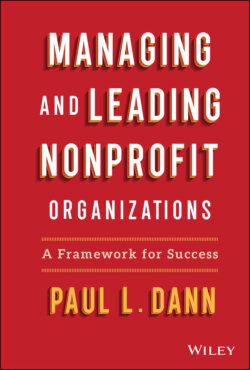Managing and Leading Nonprofit Organizations

Реклама. ООО «ЛитРес», ИНН: 7719571260.
Оглавление
Paul L. Dann. Managing and Leading Nonprofit Organizations
Table of Contents
Guide
List of Illustrations
List of Tables
Pages
MANAGING AND LEADING NONPROFIT ORGANIZATIONS. A Framework for Success
1 Introduction and Purpose of This Book
2 Leadership as Practice
First Practice Perspective: Being Antigravitational
Second Practice Perspective: The Long View
Third Practice Perspective: It's the Journey, Not the Destination
Fourth Practice Perspective: Leverage Serendipity
Fifth Practice Perspective: Use a Compass, Not a Road Map
Sixth Practice Perspective: Awareness
Seventh Practice Perspective: Address Inner Pressures
Eighth Practice Perspective: Hero Leadership versus Leading Heroes
Strategies for Developing Leadership Practice
Opportunity and Engagement
Become an Advocate for Leadership Development Practice
Find a Mentor
Sharpen Your Saw
3 Choosing a Leadership Style
Transactional Leadership
Transformational Leadership
Charismatic Leadership
Quiet Leadership
Situational Leadership
Servant Leadership
Listening
Empathy
Healing
Awareness
Persuasion
Conceptualization
Foresight
Stewardship
Commitment to Growth
Commitment to Building Strong Community
Emergent Thought in Leadership Practice
A Classic Frame
4 Creating Positive Organizational Culture. A Well‐Kept Secret
Understanding Organizational Culture
The Role of Mission, Values, and Vision
The Power of Norms
5 Leadership Development in Action: The Generative Leadership Advantage
Core Elements of Generative Leadership Practice
Expectations
Communication and Feedback
Leadership Attributes
Trust
Risk‐Taking
Opportunity
Related Subthemes
Having a Voice
Commitment
Perceived Need to Act
Organizational Philosophy and Practice
Role Modeling
Shared Beliefs and Values
Structure
6 Performance Management and Employee Engagement
Employee Engagement
Performance Management
Supervision
Summing It All Up
7 Synergy and Management Systems
Core Principles for Effective Systems
Mission Centered
Aligned with the Vision of the Organization
Support the Key Values and Beliefs
Maintaining Both Efficacy and Efficiency
Building the “We”
Meaning Making
Specific Systems
System 1: Communication Practices
Open Communication
Dynamic Communication Strategies
System 2: Meetings
System 3: Continuous Quality Improvement Practices
System 4: Professional Development
System 5: Retreats and Events
System 6: Financial Management Practices
8 Effective Change Management
Types of Change
Five Core Elements Impacting Change
Models for Pursuing Organizational Change
Resistance to Change
Strategic Planning
Step 1: The Gathering
Step 2: Refining
Step 3: The Plan
Step 4: Integrating
9 Effectively Managing Conflict
Communication and Conflict
Core Values, Culture, and Conflict
Leadership and Conflict
10 Leadership Strategies for Effective Teams
Self‐Reflection: Your Supervisory Style
Building Awareness at the Team and Individual Levels
Blind Quadrant
Unknown Quadrant
Hidden Quadrant
Open Quadrant
Understand Parallel Process
Get the Right People in the Right Place
Allow for Ownership
Support in the Right Amount at the Right Time
The Right Tools and Training
Build the Team's Culture
Celebrate and Recognize the Right People
11 Strategic Alliances
Types of Strategic Alliances
Associations
Interagency Collaboration
Networks
Mergers
Acquisitions
Key Points
Mission and Vision Alignment
Avoiding Mission Drift
Culture
Short‐Term Gain, Long‐Term Pain
Staying Ahead of the Curve
12 From Theory to Practice: Bringing It All Together
References
Appendix: Tools to Help Build Leadership Practice. Mindfulness Exercises
Mindful Breathing
Mindful Observation
Mindful Awareness
Mindful Listening
Mindful Appreciation
Leadership Practice Perspective Assessment Tool
Servant Leadership Assessment Tool
Generative Leadership® Questionnaire
Generative Leadership Questionnaire Scoring Sheet
Score Interpretation
Generative Leadership Capacity at the Three Levels
Performance Management Assessment
System Assessment Tool
Conflict Management Strategies Tool
Johari Window Team Assessment Tool
About the Author
Index. A
B
C
D
E
F
G
H
I
J
K
L
M
N
O
P
Q
R
S
T
U
V
W
Y
Z
WILEY END USER LICENSE AGREEMENT
Отрывок из книги
PAUL L. DANN
In this instance, I was thrown into a leadership role with only my wits and whatever sensibility I possessed about the human condition and what it would take for people to once again trust someone in a leadership role. Since that time, now more than 40 years later, I have come across many opportunities to develop my leadership and management capacity. Some of these opportunities mirrored my first formal leadership assignment, necessitating that I knock around in the dark with an ever‐emergent understanding of what needed to be done, a live‐and‐learn method. Other learning opportunities were more formal in nature, through training or education; some were supported by the colleagues and mentors I encountered within the field along the way; and still others came from the work itself. The people we serve, the team, and the experiences you have within the nonprofit field combine to teach you while you strive to make a difference in the world.
.....
Another strategy that you can and should pursue is the use of supervision to help you work through the challenges that are presented vis‐à‐vis the inner pressures. Effective supervision can be critical in the development of any and all leadership strategies and is particularly helpful when you are working to address inner pressures. The key is to have a strong supervisor, something that is not always a readily apparent option. When this is not an option, I recommend finding a trusted individual to serve as a mentor for your leadership practice journey (see the section on finding a mentor later in this chapter).
The eighth and final perspective that I recommend you take on is one more antigravitational effort that possesses enough in the way of dynamic layers to argue that it too meets the definition of simplexity. As you develop your leadership practice for yourself, your team, and your organization, be sure to take a stance that moves against the cultural grain of creating the lone hero leader. Instead, be sure to create heroes at all levels of the organization. Resist the urge to become a hero leader and ensure that each of your team members feels celebrated as a hero for their contribution to the organization's mission and vision.
.....